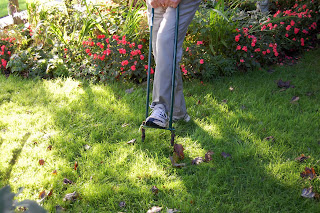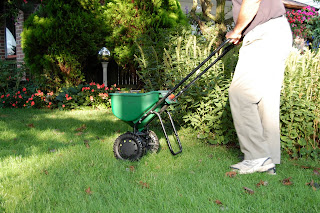The Best Lawn on the Block – without Chemicals!
~April 20, 2011
As Canada emerges from the deep freeze we tend to get pretty antsy to get out of doors. Before you can walk on your lawn and get into the garden you may satisfy your urge to enjoy the first sunny day by washing your car. At this point hosing down the driveway can feel like a trip to Florida.
After the driveway/car experience we turn our attention to the lawn.
Everyone, it seems, wants to have a nice green lawn. Even if you spend the rest of the gardening season on the golf course or at the cottage, I find that even the most negligent of lawn owners take some time in early spring to spruce up the lawn, one way or the other.
My job is to make sure that the time and money that you invest in your lawn – however little that may be – is well spent.
It must be said, too, that recent experience tells me that Canadians have a high regard for the environment. This is because we care. Not that people of other nations don’t care, it is just that we happen to care a lot. We are a country of caring people: it is part of our character.
I only say this based on my travels across the country talking about gardening everywhere that I go.
I have noticed that there is a conspiracy against the lawn, in some quarters. There are people out there who would like lawn-loving people like me to feel guilty about our nice green lawn.
Your Lawn is like a Potato.
To all of the lawn naysayers and doubters I have this to say: think of your lawn like a potato. We know that a baked potato contains all kinds of good stuff: vitamin C and D, fiber, minerals – the kind of stuff that makes you strong.
It is the stuff that you PUT on your potato that is not so good for you. “Will you have that loaded?” was the question when I was last at the Keg for a New York strip loin and baked potato side. That would be a generous helping of butter, sour cream, chives and bacon bits. I, of course, said that I was not interested in having MY potato ‘loaded’. Jeez, no. I asked her to hold the chives. Who wants chive breath?
The point of course is this: we have the option to put all kinds of stuff on our lawns that is not good for the environment.
Make no mistake: your lawn is good for the environment.
A lawn sequesters carbon, filters toxins out of rain water, eats CO2 and returns fresh oxygen to the air. It is soft to walk on bare foot, is 5 to 10 degrees cooler than asphalt and supports a host of wildlife, most of which is too small for the naked eye to see but believe you me, it is there in abundance. A handful of rich root-level subsoil is teaming with over 4 billion micro organisms: michoriza, beneficial bacteria, sow bugs, millipedes, earth worms and the like. These are the good guys.
In short – a lawn is the most sophisticated living ground cover known to mankind.
All of that said, here is how you can enjoy a nice lawn, without the use of weed or pest controls (to be performed in this order):
1. Rake your lawn lightly with a fan rake – the goal is to get the grass blades to stand upright and to remove the winter debris.

2. Aerate if necessary. I only aerate my lawn where foot traffic occurs as this is where the soil is compacted and most in need of the fresh air that you introduce when aerating. Use a power aerator if you are doing your whole lawn or buy an inexpensive manual ‘foot’ aerator at the hardware store for small areas.
3. Overseed where your lawn is thin and where weeds are a problem. Use a good quality grass seed (I recommend Golfgreen) and remember that the ultimate pedigree of your lawn is in the bag! Lay down 2 to 3 cm of triple mix (equal parts top soil, peat moss and compost). Rake smooth. Spread the grass seed thinly at one pound for 400 sq. ft (1/2 kg per 40 sq. metres). Rake THAT smooth. Water. You will thicken your lawn nicely and compete most weeds out of existence –before they even get a start!

4. Fertilize. Use a good quality fertilizer that is relatively high in nitrogen (about 20 to 28%) which is represented by the first # in the 3 number analysis. And make sure that it contains a ‘slow release’ nitrogen ingredient. This produces a greener lawn over a long period (8 to 10 weeks) AND feeds the lawn with the one element that it craves the most – nitrogen.
5. Cut 2 ½ to 3 inches high. Often we cut our lawns much too short. Remember this: the taller the grass blades the longer the roots. The longer the roots the greater the resistance to drought, disease and insect problems. AND most lawn weeds are ‘shaded out’ by long grass.
6. Mulch. Use a mulching mower and return the nitrogen-rich grass clippings to the root zone of your lawn.
7. Use a reel-type push mower. Eliminate emissions and enjoy the sound of the cutting action of an old fashioned reel-type mower. Note: the new models are much lighter than those of 30 or 40 years ago. And they hold their cutting edge much longer.
Replace your old mower. You have heard that gas driven lawn mowers are big emissions spewers… right? Well, the new lawn mowers on the market are much ‘cleaner’ burning than the old ones. Look for MTD or Honda for two of the cleanest burning brands. And avoid the 2 cycle mowers that require you to mix oil with the gas.
Just following a few of the guidelines above will improve on the environmental impact that your lawn has on your neighbourhood.
Keep your knees dirty,
Mark



